жӮЁеҘҪпјҢзҷ»еҪ•еҗҺжүҚиғҪдёӢи®ўеҚ•е“ҰпјҒ
иҝҷжңҹеҶ…е®№еҪ“дёӯе°Ҹзј–е°Ҷдјҡз»ҷеӨ§е®¶еёҰжқҘжңүе…ідҪҝз”Ёpython е®һзҺ°жү№йҮҸеӣҫзүҮиҜҶеҲ«е№¶зҝ»иҜ‘зҡ„ж–№жі•пјҢж–Үз« еҶ…е®№дё°еҜҢдё”д»Ҙдё“дёҡзҡ„и§’еәҰдёәеӨ§е®¶еҲҶжһҗе’ҢеҸҷиҝ°пјҢйҳ…иҜ»е®ҢиҝҷзҜҮж–Үз« еёҢжңӣеӨ§е®¶еҸҜд»ҘжңүжүҖ收иҺ·гҖӮ
иҜҶеҲ«иҝҮзЁӢеҰӮдёӢпјҡ
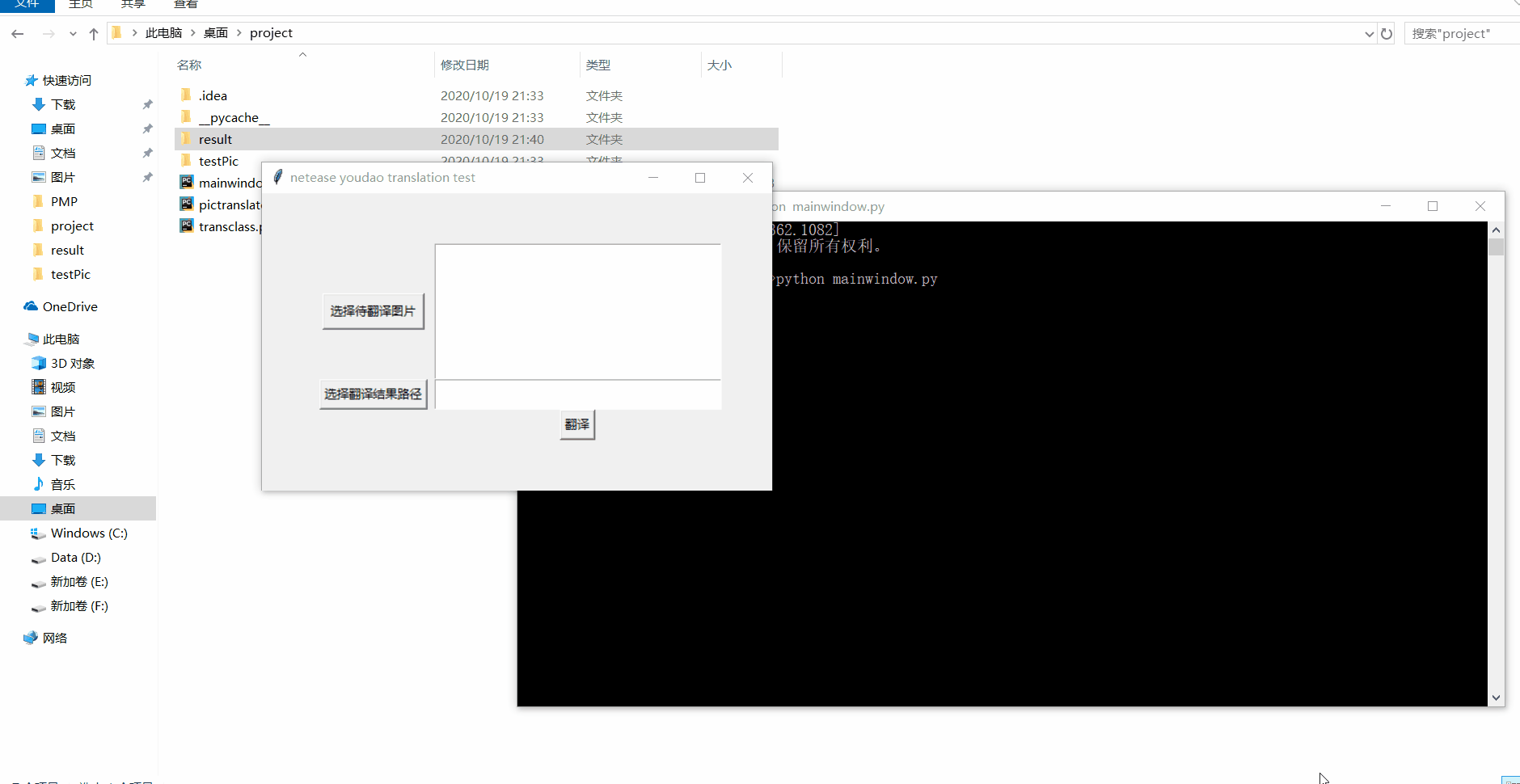
йҖҗдёӘзңӢзңӢж•Ҳжһңе“ҲпјҒmake up for ever иҷҪ然没зҝ»иҜ‘жҲҗзҺ«зҸӮиҸІпјҢе“Ҳе“Ҳе“ҲдҪҶжҳҜе…ій”®иҜҚй•ҝжңҹдҝқж№ҝгҖҒеӣәе®ҡе–·йӣҫйғҪзҝ»иҜ‘еҮәжқҘдәҶ~~жЈ’

иҝҷдёӘжӣҙжҳҜдёҚжҳҺи§үеҺү,йҹ©ж–ҮгҖҒиӢұж–Үж··еҗҲйғҪиғҪзҝ»иҜ‘~~~
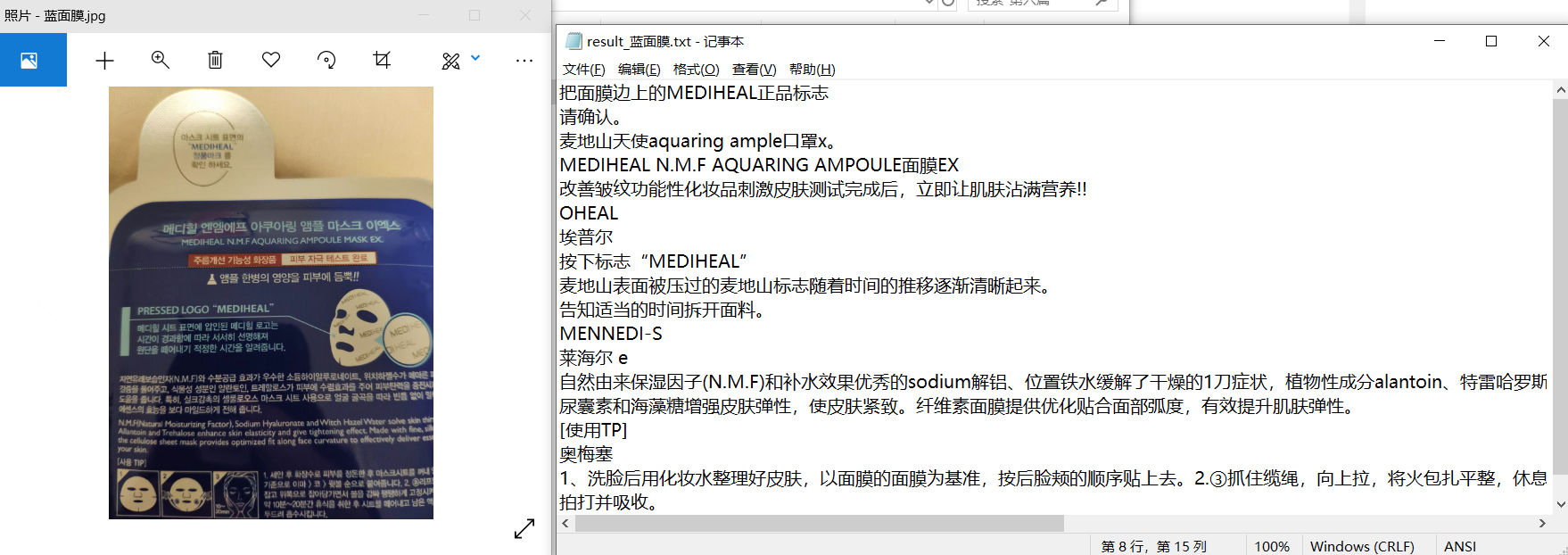
жЁұиҠұж°ҙзҡ„иЎЁзҺ°д№ҹдёҚй”ҷе“Ұ~
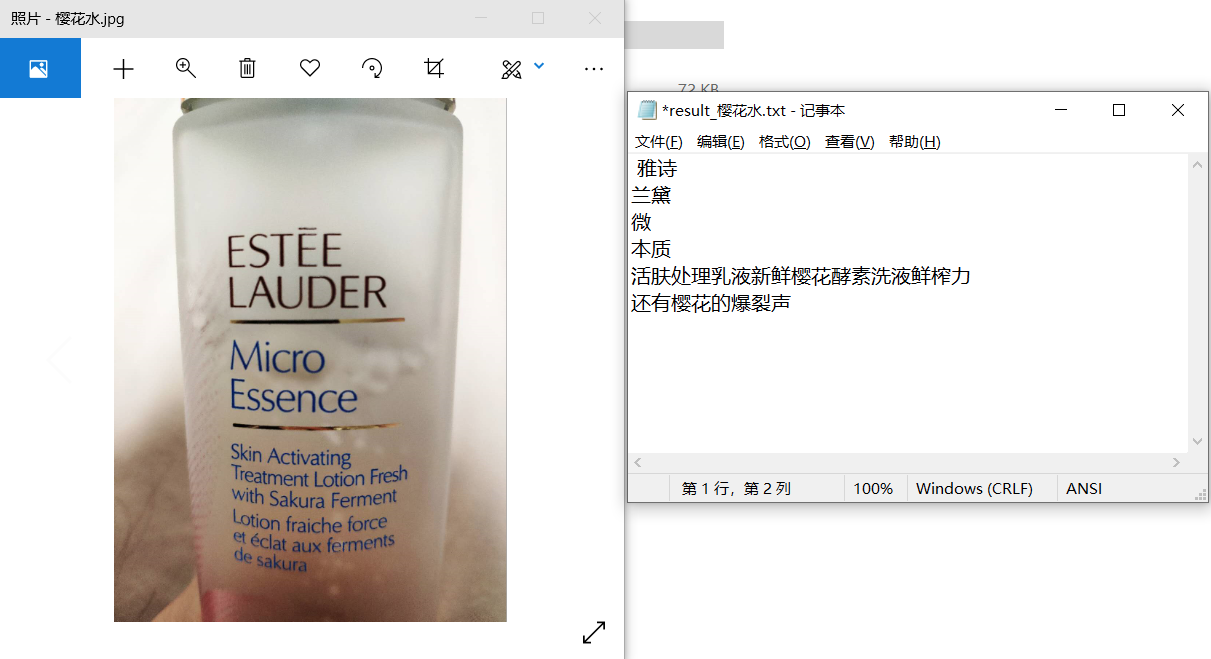
еҶҚд№ұе…ҘдёҖдёӘејҖиө·жқҘжӣҙеғҸеҢ…иЈ…зӣ’зҡ„еӣҫзүҮиҜҶеҲ«пјҢж•ҲжһңдёҚй”ҷпјҢжІЎеҸ—еӣҫзүҮдёҠж–Үеӯ—еҖҫж–ңзӯүеҪұе“Қ пјҡ
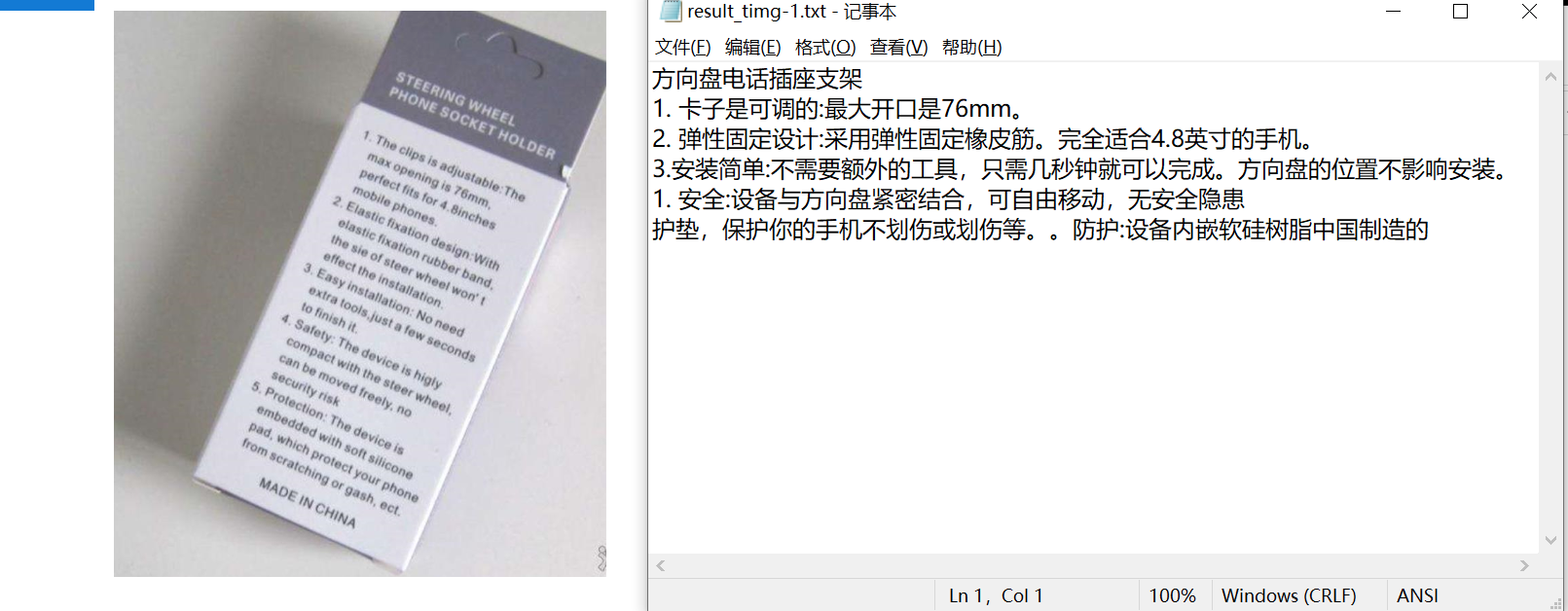
и°ғз”ЁAPIзҡ„еҮҶеӨҮе·ҘдҪңвҖ”вҖ”з”ҹжҲҗи°ғз”ЁжүҖйңҖиҰҒзҡ„еә”з”Ёidе’ҢеҜҶй’Ҙ
ж №жҚ®жңүйҒ“жҷәдә‘зҡ„жҺҘеҸЈзәҰе®ҡпјҢйңҖиҰҒе…ҲеңЁжңүйҒ“жҷәдә‘зҡ„дёӘдәәйЎөйқўдёҠз”ҹжҲҗи°ғз”ЁжүҖйңҖиҰҒзҡ„еә”з”Ёidе’ҢеҜҶй’ҘпјҢд»ҘдҫҝдҪңдёәдҪ зҡ„и°ғз”Ёж ҮиҜҶд»ҘеҸҠ收иҙ№еҸӮиҖғгҖӮгҖӮ
е…·дҪ“жӯҘйӘӨжҳҜпјҡеңЁжңүйҒ“жҷәдә‘зҡ„дёӘдәәйЎөйқўдёҠеҲӣе»әе®һдҫӢгҖҒеҲӣе»әеә”з”ЁгҖҒз»‘е®ҡеә”з”Ёе’Ңе®һдҫӢпјҢиҺ·еҸ–и°ғз”ЁжҺҘеҸЈз”ЁеҲ°зҡ„еә”з”Ёзҡ„idе’ҢеҜҶй’ҘгҖӮе…·дҪ“дёӘдәәжіЁеҶҢзҡ„иҝҮзЁӢе’Ңеә”з”ЁеҲӣе»әиҝҮзЁӢиҜҰи§Ғж–Үз« еҲҶдә«дёҖж¬Ўжү№йҮҸж–Ү件зҝ»иҜ‘зҡ„ејҖеҸ‘иҝҮзЁӢ
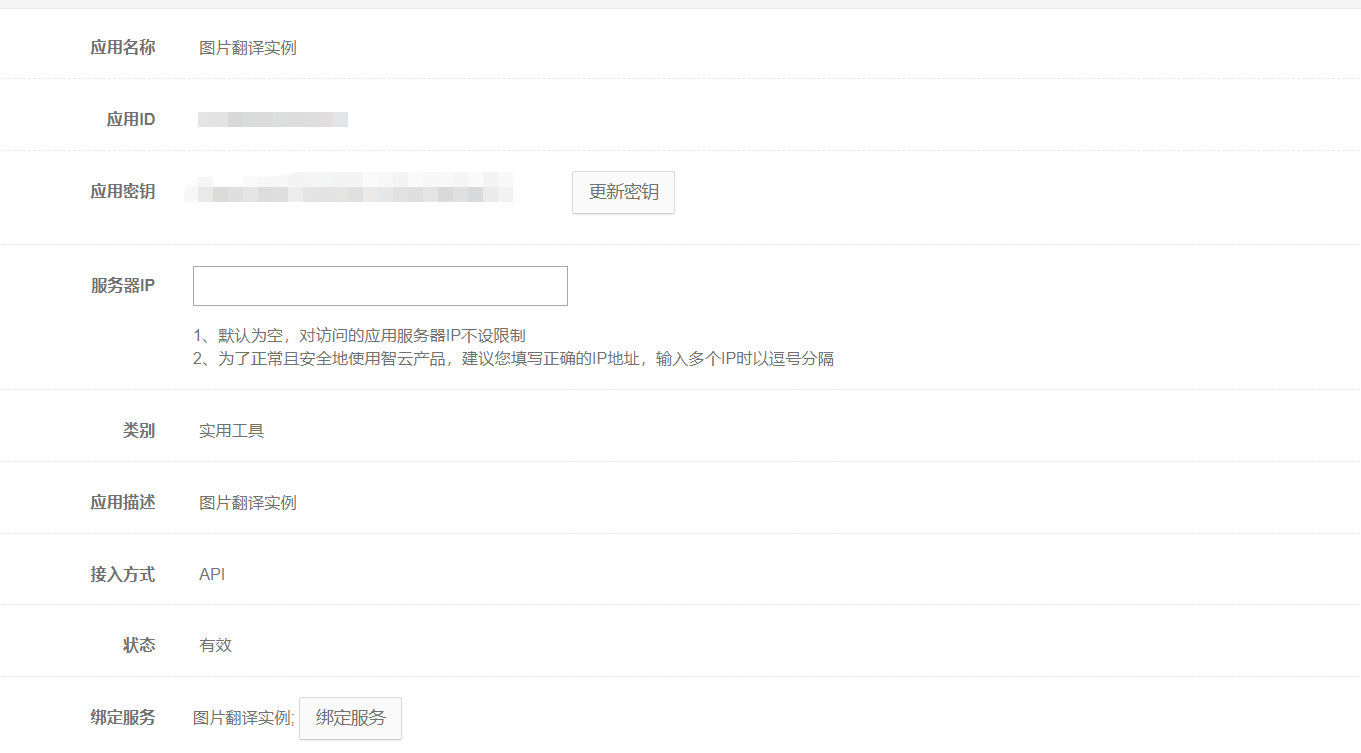
ејҖеҸ‘иҝҮзЁӢд»Ӣз»Қ
1гҖҒapiжҺҘеҸЈд»Ӣз»Қ
е…Ҳд»Ӣз»ҚдёӢиҜҘе·ҘзЁӢзҡ„ж ёеҝғйғЁеҲҶпјҢжңүйҒ“жҷәдә‘еӣҫзүҮзҝ»иҜ‘жңҚеҠЎзҡ„и°ғз”ЁжҺҘеҸЈ
API HTTPSең°еқҖпјҡhttps://openapi.youdao.com/ocrtransapi
жҺҘеҸЈи°ғз”Ёж–№ејҸпјҡPOST
иҜ·жұӮж јејҸпјҡиЎЁеҚ•
зӣёеә”ж јејҸпјҡJSON
жҺҘеҸЈи°ғз”ЁеҸӮж•°
и°ғз”ЁAPIйңҖиҰҒеҗ‘жҺҘеҸЈеҸ‘йҖҒд»ҘдёӢеӯ—ж®өжқҘи®ҝй—®жңҚеҠЎгҖӮ
| еӯ—ж®өеҗҚ | зұ»еһӢ | еҗ«д№ү | еҝ…еЎ« | еӨҮжіЁ |
|---|---|---|---|---|
| type | text | ж–Ү件дёҠдј зұ»еһӢ | True | зӣ®еүҚж”ҜжҢҒBase64пјҢиҜ·зҪ®иҜҘеӯ—ж®өеҖјдёә1 |
| from | text | жәҗиҜӯиЁҖ | True | еҸӮиҖғдёӢж–№зҡ„ ж”ҜжҢҒиҜӯиЁҖ (еҸҜи®ҫзҪ®дёәauto) |
| to | text | зӣ®ж ҮиҜӯиЁҖ | True | еҸӮиҖғдёӢж–№зҡ„ ж”ҜжҢҒиҜӯиЁҖ (еҸҜи®ҫзҪ®дёәauto) |
| appKey | text | еә”з”ЁID | True | еҸҜеңЁ еә”з”Ёз®ЎзҗҶ жҹҘзңӢ |
| salt | text | UUID | True | 1995882C5064805BC30A39829B779D7B |
| sign | text | зӯҫеҗҚ | True | md5(еә”з”ЁId+q+salt+еә”з”ЁеҜҶй’Ҙ) |
| ext | text | зҝ»иҜ‘з»“жһңйҹійў‘ж јејҸпјҢж”ҜжҢҒmp3 | false | mp3 |
| q | text | иҰҒиҜҶеҲ«зҡ„еӣҫзүҮ | true | typeдёә1ж—¶еҝ…еЎ«,еӣҫзүҮзҡ„Base64зј–з Ғ |
| docType | text | жңҚеҠЎеҷЁе“Қеә”зұ»еһӢпјҢзӣ®еүҚеҸӘж”ҜжҢҒjson | false | json |
| render | text | жҳҜеҗҰйңҖиҰҒжңҚеҠЎз«Ҝиҝ”еӣһжёІжҹ“зҡ„еӣҫзүҮпјҢ0пјҡеҗҰпјӣ1пјҡжҳҜпјҢй»ҳи®ӨжҳҜ0 | false | 0 |
| nullIsError | text | еҰӮжһңocrжІЎжңүжЈҖжөӢеҲ°ж–Үеӯ—пјҢжҳҜеҗҰиҝ”еӣһй”ҷиҜҜпјҢfalseпјҡеҗҰпјӣtrueпјҡжҳҜпјҢй»ҳи®ӨжҳҜfalse | false | жіЁж„ҸжҳҜеӯ—з¬ҰдёІ |
зӯҫеҗҚз”ҹжҲҗж–№жі•еҰӮдёӢпјҡ
1гҖҒе°ҶиҜ·жұӮеҸӮж•°дёӯзҡ„ еә”з”ЁID appKey , еӣҫзүҮзҡ„Base64зј–з Ғ q ,UUID salt е’Ң еә”з”ЁеҜҶй’Ҙ жҢүз…§ еә”з”ЁID+q+salt+еә”з”ЁеҜҶй’Ҙзҡ„йЎәеәҸжӢјжҺҘеҫ—еҲ°еӯ—з¬ҰдёІ str гҖӮ
2гҖҒеҜ№еӯ—з¬ҰдёІ str еҒҡ md5пјҢеҫ—еҲ°32дҪҚеӨ§еҶҷзҡ„ sign (еҸӮиҖғJavaз”ҹжҲҗMD5зӨәдҫӢ,еҸҜзӮ№еҮ»еҸідҫ§зҡ„JAVAзӨәдҫӢ)гҖӮ
иҫ“еҮәз»“жһң
иҝ”еӣһзҡ„з»“жһңжҳҜjsonж јејҸпјҢе…·дҪ“иҜҙжҳҺеҰӮдёӢпјҡ
| еӯ—ж®өеҗҚ | еӯ—ж®өиҜҙжҳҺ |
|---|---|
| orientation | еӣҫзүҮжүҖеҜ№еә”зҡ„ж–№еҗ‘ |
| lanFrom | ocrжүҖиҜҶеҲ«еҮәжқҘи®Өдёәзҡ„еӣҫзүҮдёӯзҡ„иҜӯиЁҖ |
| textAngle | еӣҫзүҮзҡ„еҖҫж–ңи§’еәҰ |
| errorCode | й”ҷиҜҜз Ғ |
| lanTo | зӣ®ж ҮиҜӯиЁҖ |
| resRegions | еӣҫзүҮзҝ»иҜ‘зҡ„е…·дҪ“еҶ…е®№ |
| -boundingBox | еҢәеҹҹиҢғеӣҙпјҢеӣӣдёӘеҖјпјҡ е·ҰдёҠи§’зҡ„xеҖјпјҢе·ҰдёҠи§’зҡ„yеҖјпјҢеҢәеҹҹзҡ„зҡ„е®ҪпјҢеҢәеҹҹзҡ„й«ҳ дҫӢеҰӮпјҡ134,0,1066,249 |
| -linesCount | иЎҢж•°пјҲз”ЁдәҺеүҚз«ҜжҺ’зүҲпјү |
| -lineheight | иЎҢй«ҳ |
| -context | иҜҘеҢәеҹҹзҡ„еҺҹж–Ү |
| -linespace | иЎҢй—ҙи·қ |
| -tranContent | зҝ»иҜ‘з»“жһң |
2гҖҒиҜҰз»ҶејҖеҸ‘
иҝҷдёӘdemoдҪҝз”Ёpython3ејҖеҸ‘пјҢеҢ…жӢ¬maindow.pyпјҢtransclass.pyпјҢpictranslate.pyдёүдёӘж–Ү件гҖӮmaindow.pyдё»иҰҒе®һзҺ°з•ҢйқўйғЁеҲҶпјҢдҪҝз”ЁpythonиҮӘеёҰзҡ„tkinterеә“пјҢжқҘиҝӣиЎҢеӣҫзүҮж–Ү件йҖүжӢ©гҖҒйҖүжӢ©з»“жһңеӯҳж”ҫи·Ҝеҫ„гҖӮtransclass.pyе®һзҺ°дәҶеӣҫзүҮиҜ»еҸ–гҖҒеӨ„зҗҶзӯүйҖ»иҫ‘пјҢжңҖеҗҺйҖҡиҝҮpictranslate.pyдёӯзҡ„ж–№жі•жқҘи°ғз”ЁеӣҫзүҮзҝ»иҜ‘APIгҖӮ
1гҖҒз•ҢйқўйғЁеҲҶ
дё»иҰҒе…ғзҙ пјҡ
root=tk.Tk()
root.title("netease youdao translation test")
frm = tk.Frame(root)
frm.grid(padx='50', pady='50')
btn_get_file = tk.Button(frm, text='йҖүжӢ©еҫ…зҝ»иҜ‘еӣҫзүҮ', command=get_files)
btn_get_file.grid(row=0, column=0, ipadx='3', ipady='3', padx='10', pady='20')
text1 = tk.Text(frm, width='40', height='10')
text1.grid(row=0, column=1)
btn_get_result_path=tk.Button(frm,text='йҖүжӢ©зҝ»иҜ‘з»“жһңи·Ҝеҫ„',command=set_result_path)
btn_get_result_path.grid(row=1,column=0)
text2=tk.Text(frm,width='40', height='2')
text2.grid(row=1,column=1)
btn_sure=tk.Button(frm,text="зҝ»иҜ‘",command=translate_files)
btn_sure.grid(row=2,column=1)
root.mainloop()иҺ·еҸ–еҫ…зҝ»иҜ‘еӣҫзүҮж–Ү件зҡ„ж–№жі•пјҲжӯӨеӨ„и®ҫзҪ®зҡ„д»…ж”ҜжҢҒ.jpgж–Ү件пјүпјҡ
def get_files():
files = filedialog.askopenfilenames(filetypes=[('text files', '.jpg')])
translate.file_paths=files
if files:
for file in files:
text1.insert(tk.END, file + '\n')
text1.update()
else:
print('дҪ жІЎжңүйҖүжӢ©д»»дҪ•ж–Ү件')иҺ·еҸ–з»“жһңеӯҳеӮЁи·Ҝеҫ„:
def set_result_path(): result_path=filedialog.askdirectory() translate.result_root_path=result_path text2.insert(tk.END,result_path)
зҝ»иҜ‘жҢүй’®пјҢи°ғз”ЁдәҶtranslate_filesпјҢиҜҘж–Ү件дёӯзҡ„translate_files()ж–№жі•жңҖз»Ҳи°ғз”ЁдәҶtranslateзұ»зҡ„translate_files()ж–№жі•пјҡ
def translate_files():
if translate.file_paths:
translate.translate_files()
tk.messagebox.showinfo("жҸҗзӨә","жҗһе®ҡ")
else :
tk.messagebox.showinfo("жҸҗзӨә","ж— ж–Ү件")2гҖҒжү№йҮҸеӣҫзүҮеӨ„зҗҶ
transclass.pyе®һзҺ°дәҶеӣҫзүҮиҜ»еҸ–гҖҒеӨ„зҗҶзӯүйҖ»иҫ‘пјҢTranslateзұ»е®ҡд№үеҰӮдёӢпјҡ
class Translate():
def __init__(self,name,file_paths,result_root_path,trans_type):
self.name=name
self.file_paths=file_paths # еҫ…зҝ»иҜ‘ж–Ү件и·Ҝеҫ„
self.result_root_path=result_root_path # з»“жһңеӯҳж”ҫи·Ҝеҫ„
self.trans_type=trans_type
def translate_files(self):
for file_path in self.file_paths: #еҜ№жү№йҮҸеӣҫзүҮйҖҗдёӘеӨ„зҗҶ
file_name=os.path.basename(file_path)
print('==========='+file_path+'===========')
trans_reult=self.translate_use_netease(file_path) #еҜ№еҚ•дёӘеӣҫзүҮи°ғз”ЁжҺҘеҸЈ
resul_file=open(self.result_root_path+'/result_'+file_name.split('.')[0]+'.txt','w').write(trans_reult) #иҝ”еӣһз»“жһңеҶҷе…Ҙ
def translate_use_netease(self,file_content): #и°ғз”ЁжңүйҒ“жҺҘеҸЈпјҢ并иҝ”еӣһз»“жһң
result= connect(file_content)
return result3гҖҒжңүйҒ“apiи°ғз”Ё
pictranslate.pyдёӯе°ҒиЈ…дәҶи°ғз”ЁжңүйҒ“жҷәдә‘APIзҡ„дёҖдәӣж–№жі•пјҢе…¶дёӯжңҖж ёеҝғзҡ„жҳҜconnect()ж–№жі•пјҢжҢүз…§жҺҘеҸЈиҰҒжұӮжӢјжҺҘдәҶжүҖйңҖеҸӮж•°пјҢеҸ‘иө·иҜ·жұӮ并иҝ”еӣһз»“жһңгҖӮ
def connect(file_content,fromLan,toLan):
f = open(file_content, 'rb') # дәҢиҝӣеҲ¶ж–№ејҸжү“ејҖеӣҫж–Ү件
q = base64.b64encode(f.read()).decode('utf-8') # иҜ»еҸ–ж–Ү件еҶ…е®№пјҢиҪ¬жҚўдёәbase64зј–з Ғ
f.close()
data = {}
# data['from'] = 'жәҗиҜӯиЁҖ'
# data['to'] = 'зӣ®ж ҮиҜӯиЁҖ'
data['from'] = 'auto'
data['to'] = 'auto'
data['type'] = '1'
data['q'] = q
salt = str(uuid.uuid1())
signStr = APP_KEY + q + salt + APP_SECRET
sign = encrypt(signStr)
data['appKey'] = APP_KEY
data['salt'] = salt
data['sign'] = sign
response = do_request(data)
result=json.loads(str(response.content, encoding="utf-8"))
print(result)
translateResults=result['resRegions']
print(translateResults)
pictransresult=""
for i in translateResults:
pictransresult=pictransresult+i['tranContent']+"\n"
return pictransresultдёҠиҝ°е°ұжҳҜе°Ҹзј–дёәеӨ§е®¶еҲҶдә«зҡ„дҪҝз”Ёpython е®һзҺ°жү№йҮҸеӣҫзүҮиҜҶеҲ«е№¶зҝ»иҜ‘зҡ„ж–№жі•дәҶпјҢеҰӮжһңеҲҡеҘҪжңүзұ»дјјзҡ„з–‘жғ‘пјҢдёҚеҰЁеҸӮз…§дёҠиҝ°еҲҶжһҗиҝӣиЎҢзҗҶи§ЈгҖӮеҰӮжһңжғізҹҘйҒ“жӣҙеӨҡзӣёе…ізҹҘиҜҶпјҢж¬ўиҝҺе…іжіЁдәҝйҖҹдә‘иЎҢдёҡиө„и®Ҝйў‘йҒ“гҖӮ
е…ҚиҙЈеЈ°жҳҺпјҡжң¬з«ҷеҸ‘еёғзҡ„еҶ…е®№пјҲеӣҫзүҮгҖҒи§Ҷйў‘е’Ңж–Үеӯ—пјүд»ҘеҺҹеҲӣгҖҒиҪ¬иҪҪе’ҢеҲҶдә«дёәдё»пјҢж–Үз« и§ӮзӮ№дёҚд»ЈиЎЁжң¬зҪ‘з«ҷз«ӢеңәпјҢеҰӮжһңж¶үеҸҠдҫөжқғиҜ·иҒ”зі»з«ҷй•ҝйӮ®з®ұпјҡis@yisu.comиҝӣиЎҢдёҫжҠҘпјҢ并жҸҗдҫӣзӣёе…іиҜҒжҚ®пјҢдёҖз»ҸжҹҘе®һпјҢе°Ҷз«ӢеҲ»еҲ йҷӨж¶үе«ҢдҫөжқғеҶ…е®№гҖӮ
жӮЁеҘҪпјҢзҷ»еҪ•еҗҺжүҚиғҪдёӢи®ўеҚ•е“ҰпјҒ